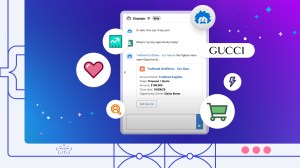No company should have to compromise its vision for customer experience because it lacks the right connectivity between applications or views of customer data. That’s why at our Dreamforce conference today in San Francisco, we launched Salesforce Customer 360, a new way for companies to transcend organizational and data siloes. Central to Salesforce’s vision for the Customer Success Platform, Customer 360 will include a click-based UI for app and data management across clouds, a reconciled 360 ID that will act as the single place to access data for each customer, and a set of pre-built packages for companies to get up and running quickly.
Patrick Stokes, Senior Vice President of Product Management, is leading the development of Customer 360. We caught up with him and got his thoughts on how it will empower Salesforce admins and help companies connect with customers in entirely new ways.
What has been your experience at Salesforce, and how did you come to this role?
I joined Salesforce in 2012 through an acquisition in the social marketing space, and at that time it was just beginning the company’s initial push into B2C and understanding that behind every company and product is a customer. A short time after I joined, we acquired ExactTarget and the Salesforce Marketing Cloud was born.
The people I worked with helped open my eyes to thinking about marketing as part of something much bigger— which is CRM. At the end of the day, that’s what we’re doing here every day at Salesforce. We’re helping our customers manage relationships with their customers in exciting new ways. It’s that background of coming in from an acquisition and starting with a beginner’s mind that led me to spearhead the development of Customer 360.
What is Customer 360, and what problem is it solving for?
To truly provide the type of experience that your customer expects, you need to know who the customer is and have the right tools and data at your fingertips. That isn’t a new idea, and companies have been talking about this for ages. But it is a really difficult thing to achieve in today’s environment. The number of touchpoints you have with your customer is probably bigger than you know, and worse, you no longer have control over how and when your customer will interact with you.
Every day, more and more customers are using Salesforce solutions as the front door to their customers, which makes it our responsibility to solve for some of the basic elements of the problem I just described. Salesforce has a strong point of view that the foundation of a CRM solution is identifying and knowing your customer. So, Customer 360 is a graph of data about your customer from across all of your Salesforce solutions in your organization. And now with MuleSoft, which is part of Salesforce, we can extend that graph to your third-party and legacy systems, which is absolutely crucial in obtaining a more complete customer view.
People talk about a “single” view of the customer, which implies all of this data is stored somewhere centrally, but that’s not our philosophy. We believe strongly that a graph of data about your customer combined with a standard way for each of your applications to access that data, without dumping all the data into the same repository, is the right technical approach. Five years ago we probably couldn’t have done this, but now that more and more companies are adopting Salesforce for Marketing, Service, and Commerce we are incredibly excited about our ability to surface this graph in our applications without going through the laborious and inefficient process of moving all the data.
So what does this all mean? It means your marketers, service agents, sales reps, merchandisers…they will all have a more complete view of the customer. And as a result of that view, they’ll be able to create more coordinated and personalized approaches to their interactions.
How will Customer 360 change how people work?
In short, it’s going to make everyone’s job a little bit more enjoyable. Imagine a service agent not having to go to three or four different systems to handle a case. Imagine a marketer being able to coordinate a campaign without having to think through how they are going to get access to certain pieces of data, such as what they recently bought from a brand. Imagine being able to design an AI model that understands more about your customer than ever before, because it has more data to work with than ever before.
Once you eliminate all of the point-to-point, one-time-use data integrations, you can really focus on the customer experience. That’s what we want for our customers. We want companies to really think about their customer experiences. We don’t want them to compromise their vision for customer experience because of technical challenges.
How would people have connected their clouds previously? What makes Customer 360 truly innovative?
The way many organizations connect their systems is not great. I see two patterns, which aren’t specific to Salesforce but rather the industry at large. First, we see connectivity problems being solved with a one-time solution. They solve for their specific use-case because they need it fast and there is no reusability for the next business problem to leverage later. And second, we see that the solution is often to pick data up from one system and duplicate it on another. This concerns me. Proliferating data across systems is not an efficient or safe solution.
What makes Customer 360 different is that we’re leaving data where it belongs, in the systems that manage it. We’re simply putting a graph on top of the data from our clouds so that we know where it is and how to retrieve it when we need it. We think this is a faster and safer solution, and it can all be managed by Salesforce admins, without the need for development work.
What is the business value of Customer 360?
The intrinsic value is that your business owners, your employees, and most importantly, your customers will be happier because their experiences will be dramatically improved.
The business value exists in the reduction of time and costs, and also reduction of risk by eliminating unnecessary duplication of customer data when creating your customer-facing experiences and applications. If your customers can spend less time on a service call, or get a more personalized product recommendation, they are going to be happier and more loyal.
Tell us about some of the challenges faced when building Customer 360.
Customer 360 is the largest cross-cloud (which is Salesforce-speak for “crosses multiple org-charts”) project in the history of our company In a lot of ways, this has been an interesting project because the challenges that we are facing are the same challenges that our customers are facing—connecting data and systems across the organization.
Every day I talk to customers who are struggling to bring data together, to reconcile it, and then to access it back in relevant applications. The opportunity to help them fix this is very exciting.













